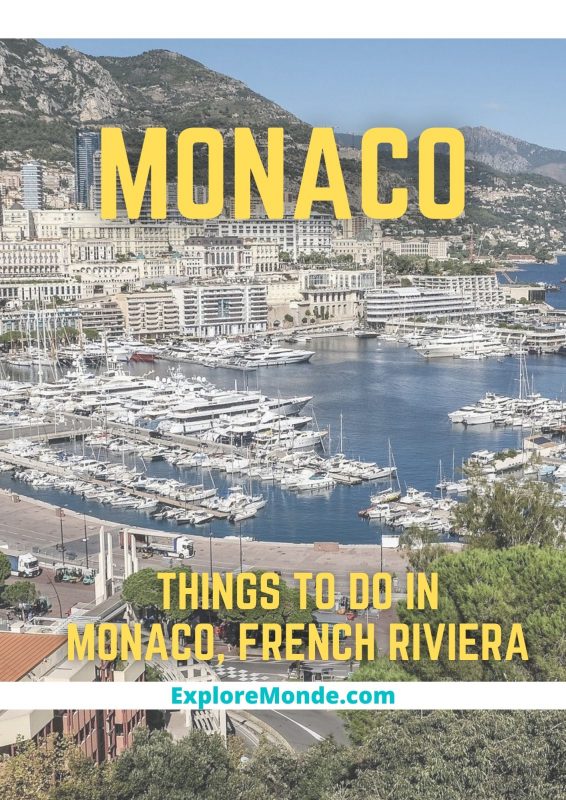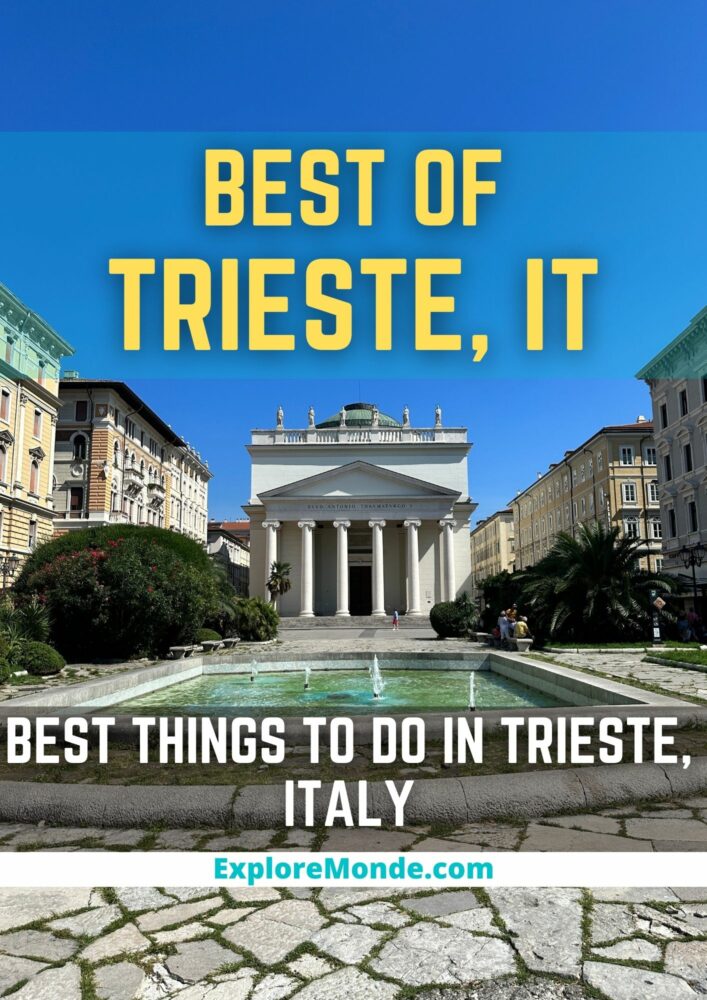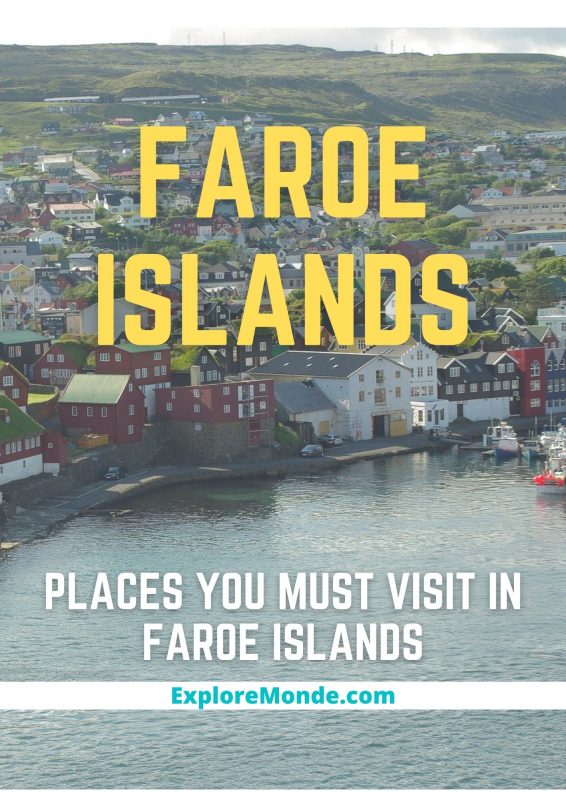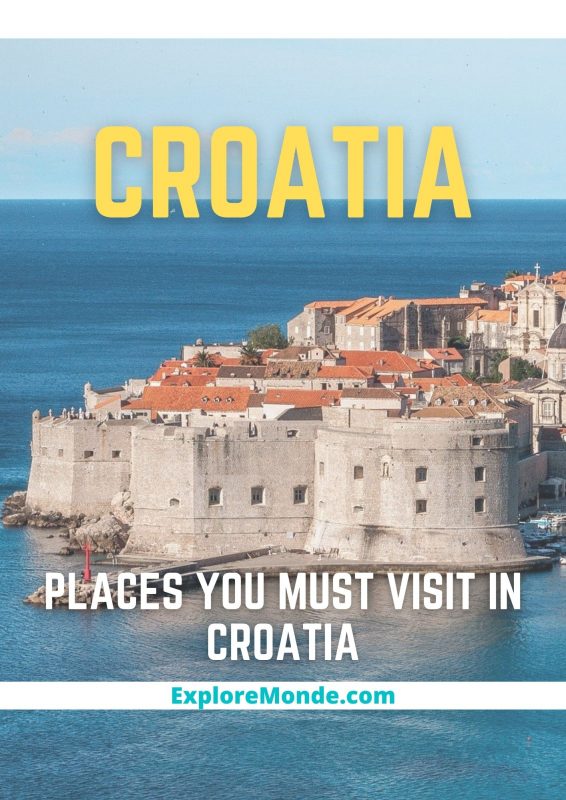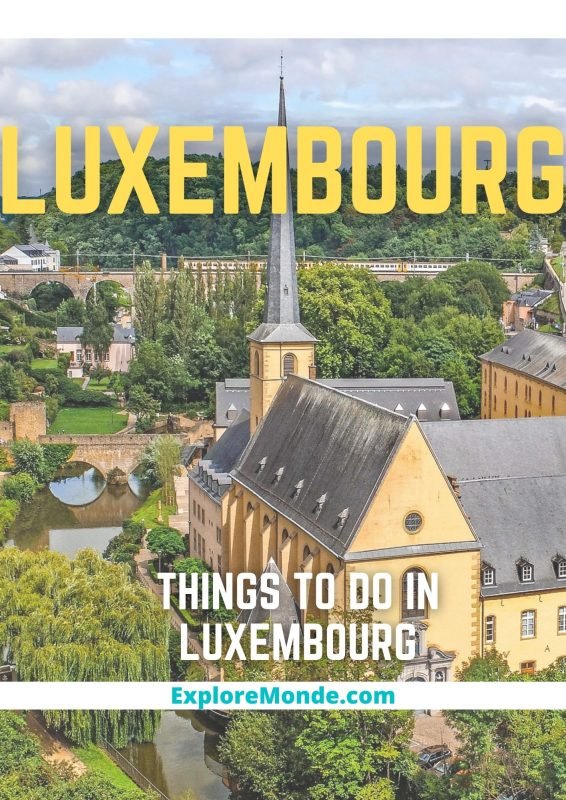This article has been reviewed by Laura and Sumeet, travel enthusiasts who have travelled to 40+ countries. (Follow @Ciao.Namaste on Youtube). Should you have any inquiries, please do not hesitate to contact at contact@exploremonde.com
Prague, the capital city of the Czech Republic, is also the country’s commercial and cultural center. Prague is a historic city on the Vltava River in the Kingdom of Bohemia. Prague has been home to many famous people including Franz Kafka, John Lennon, and Mozart. The English word “chess” comes from a special kind of chess played in the late 16th century by Queen Elizabeth I of England and her ladies-in-waiting.
Prague is home to the oldest astronomical clock in the world, which was first installed in 1410. The city has more than ten major museums, including the National Museum and the Museum of Communism.
Tourists flock to Prague for its fairytale beauty, long history, and rich culture. The city was founded in the 9th century by Prince Bořivoj II of Brno who made it his home base while he tried to expand his territory by conquering other parts of Bohemia.
Here’s a list of the 21 best things to do in Prague, Czech Republic.
- 1. Infant Jesus of Prague
- 2. Old Town Square
- 3. The Astronomical Clock
- 4. Charles Bridge
- 5. Old Jewish Ghetto
- 6. Prague Castle, also called the ‘Crown of Bohemia’
- 7. St Vitus Cathedral
- 8. Golden Lane
- 9. KGB Museum, Prague
- 10. Stare Mesto (Old Town)
- 11. The Lennon Wall, Prague
- 12. Farmer’s market
- 13. Vltava River
- 14. Mala Strana
- 15. Nightlife in Prague
- 16. Petrin Hill
- 17. Letna Park
- 18. Mind Maze
- 19. Jelení Príkop (Stag Moat)
- 20. Beer Tours in Prague
- 21. Wenceslas Square (Czech: Václavské náměstí)
Magical Prague during fall 🍂 Czech Republic 🇨🇿 pic.twitter.com/lG53P4iFbI
— Jerimiah Treefrog (@WorldOfPicture5) May 31, 2022
How to Reach
To reach Prague, the Czech Republic from a different country, you must first get to the city of your departure and locate the closest airport. Prague, Czech Republic has one airport: Prague Ruzyne International Airport (PRG). This airport is located about 13 miles (20 km) northwest of the city center.
The best way to reach Prague from the airport is by taking the bus. Public bus number 119 takes you directly into the city center for 150 Czech Crowns. You can also take a taxi if you wish, but this will be a more expensive option.
Best Things to do in Prague 1-10
1. Infant Jesus of Prague
As the legend continues, the statue was taken to what is now known as Brno, Czechoslovakia. The statue disappeared during World War II when Nazi troops invaded Brno. After the war, an unknown man brought the statue to be hidden in a wooden hut near Pisek, Czechoslovakia.
Church of Our Lady Victorious, also referred as the Shrine of the Infant Jesus of Prague, in Malá Strana, the “Lesser Quarter” of Prague. pic.twitter.com/yefspGniEA
— Pictures of Churches (@ChurchPictures8) September 7, 2019
During the communist regime in Czechoslovakia, families wanted to visit the statue but could not because it was kept under strict security by the communist regime.
Not until after the 1989 Velvet Revolution was the statue again started to be publicly venerated. The location of the secret wooden hut where it had been hidden for so many years was still unknown, and in 1993 the statue of Baby Jesus was given to an Italian priest, Father Renzo Zocca, who took it to Italy.
Bestseller Drones
Zocca built a shrine in the Church of Madonna Della Ghiara, in Modena Italy, and laid the statue on a bed of silk next to an image of Mary and Jesus. The statue remains there today.
In the Czech Republic, faithful Catholics kept praying before this statue of Baby Jesus, asking for his protection and miraculous help. The statue that was hidden in the Czech Republic during communist persecution remains there today.
2. Old Town Square
The Old Town Square is a town square in Old Town, Prague within the Prague 1 district. It forms the heart of the business and cultural center of the city and is often considered to be one of the most beautiful squares in Europe. This historic square has changed its appearance through the recent centuries. It is currently surrounded by buildings dating from the Middle Ages, the Renaissance, and Baroque periods, as well as structures that were erected during the socialist era.
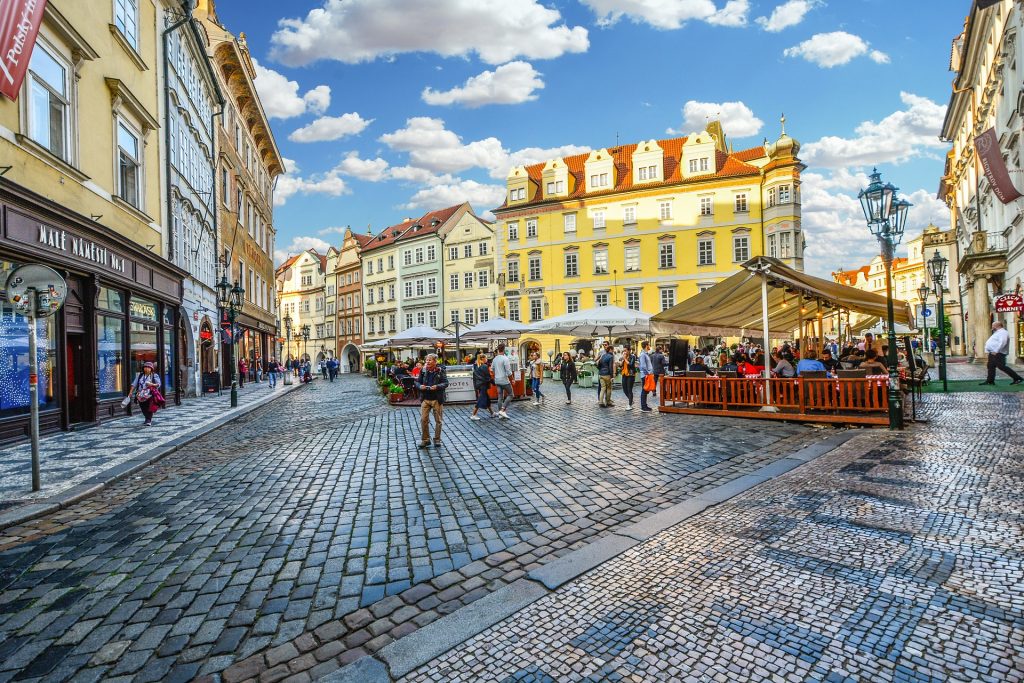
The Old Town Square was originally named “Town Squares” (Czech: Starem trzi). It was an important part of Medieval Prague, first mentioned in the 12th century. It was probably originally laid out at the beginning of the 13th century. The square was enlarged several times by the members of the royal Vratislavic dynasty, who ruled Bohemia until they died out in 1306, and it eventually assumed its present shape with an area of more than 10,000 m (110,000 sq ft), with some minor corrections in the 18th century.
In 1348, as part of a program to improve civic amenities, King Charles IV ordered several waterworks to be established around the square, which was accordingly renamed Water Square (now Stare trzi). The square’s centerpiece is a stone pillar crowned by a statue of Saint John of Nepomuk, which has witnessed many historic events in the square. The column was originally erected in 1475 using funds provided by King Vladislav II. During the Hussite Wars, it served as a place for the gathering of militia forces. Later, when Protestantism was accepted in Bohemia by the reigning Austrian Habsburg dynasty, it became the center of religious conflict. The Old Town Square continued to be an exclusive bourgeois area built up by adding more buildings.
Bestseller GoPro Selfie Sticks
The city’s largest church – St. Nicholas Church (Czech: Kostel sv. Mikuláše) was founded in 1365 on the eastern side of the square by King Charles IV. The church was reconstructed in 1836 by Josef Kranner and in 1870 the interior was decorated with frescoes by Mikuláš Aleš.
On the opposite side of the square is the Old Town Hall Tower originally built during 1257–1300, with its present-day astronomical clock dating from 1860. The original clock, constructed in 1410, was the first one to employ a minute hand.
The Old Town Hall is surrounded by several historic houses depicting various architectural styles which add to the picturesque nature of the square. The Merchant’s House at No. 7 dates from the late 15th century and features a Gothic doorway from 1493 to the first refitting period after 1470. The House of the Black Madonna at No. 15 (“U černé Matky boží”) is a 16th-century building with rich Baroque interiors. Its façade was renewed in 1679–90, with an added balcony from 1714 which still stands today.
The House of the Blue Rose (“U modrého růže”) at No. 11 houses a City Museum (“Muzeum Mesta Prahy”) with an exposition of the historical development of Prague. The Centre for Jewish Art at No. 4 is a synagogue and the only surviving fragment of the old Jewish ghetto.
In front of the Old Town Hall, there is a Monument to the Three Kings which commemorates the arrival of the Magi to Bethlehem. The monument is a replica of a statue in Wroclaw, Poland.
Bestseller Copper Water Bottles
A wooden platform used to be at the foot of the pillar with a small turret that carried a large gilded or golden Madonna. The turret clock was first installed in 1410.
The present-day monument to the Three Kings was erected as a replacement for an older statue, which had been destroyed during the Hussite Wars in 1420. A replica was installed on 19 April 1991 (St. George’s Day). The statue is Bohemia’s largest outdoor nativity scene and it is popular with tourists. The whole structure was renovated in 2011 to connect all platforms and street-level viewing areas into one contiguous platform surrounding the column.
The clock, which still shows only an hour’s hand, displays moving models of three Magi and a procession of the Apostles as well as a calendar, the zodiac signs, and an early image of Prague. It still keeps a very accurate time using its original mechanism.
The Old Town Square is annually used for an ice skating rink during the winter as well as a venue for numerous events, such as a New Year’s Eve celebration, the Prague Proms concert series, and various markets.
3. The Astronomical Clock
The Astronomical Clock is a clock located in Prague, right outside Old Town Square. The clock has been a major feature of this area for over 600 years.
Bestseller Cupholder Bottles
In the 15th century, a large Gothic clock was installed above the entrance to Old Town city hall. This original clock did not include all the features currently seen in the clock. A few additional mechanisms were added later, but it was not until 1490 that Hanuš, the clockmaker, added the mechanism that allowed for the display of religious feasts. The clock was then altered in 1552 when it started to show the positions of planets. This original clock was destroyed in 1689 by an anti-Habsburg revolt that left the square in ruins.
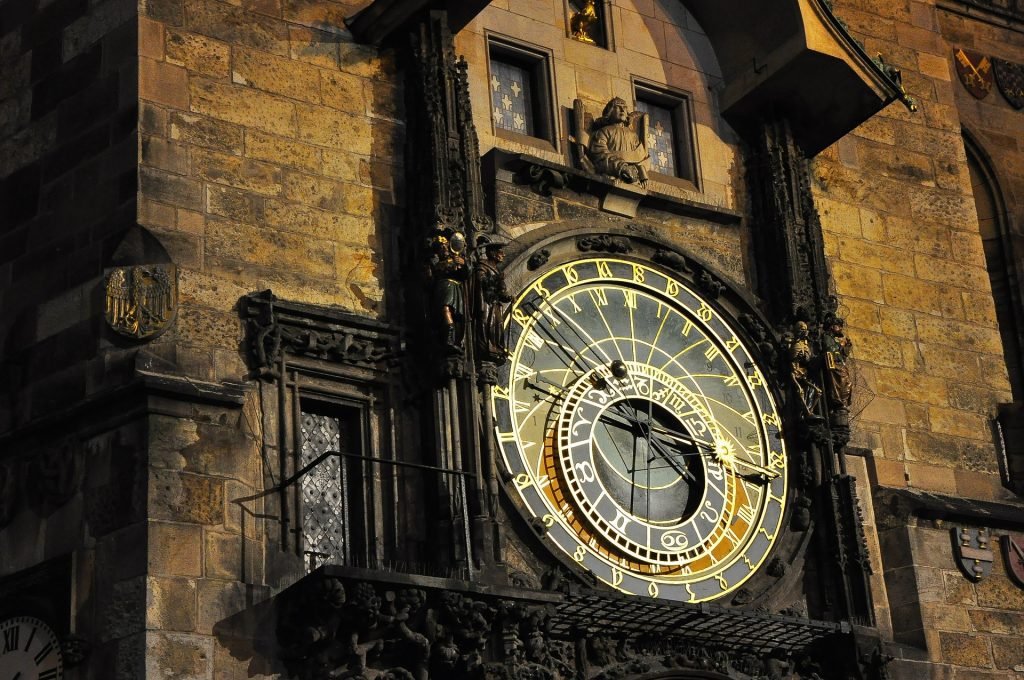
In 1490, there were only two dials, showing the time of day and including a calendar. In addition to this, an astrolabe mechanism depicted the moon’s phases and move through its orbit around Earth. All these features were financed by a tax levied on all Jews living in Prague, who was thought to be responsible for the Black Death ravaging Europe.
Also added was a disc showing the current date, month, and zodiac signs. The astrolabe disc is estimated to have been completed by 1520, while according to one source, Hanuš finished the construction of the clock in 1490. The clock’s main feature, the mechanical procession of Apostles and other figures, was added in 1552.
In 1629, a gilded cock was placed on top of the spire as a weather vane. In 1895–1905, this cock was replaced by a copper one which now stands above Prague National Museum. This is when the clock as it appears now was built.
4. Charles Bridge
Charles Bridge is a stone Gothic bridge that crosses the Vltava River in Prague, Czech Republic. It links the Old Town and Malá Strana. The construction of this landmark began as early as 1357 under the auspices of King Charles IV. The original construction went from 1170 to 1402. In addition to its beauty, it offers some historical significance as well.
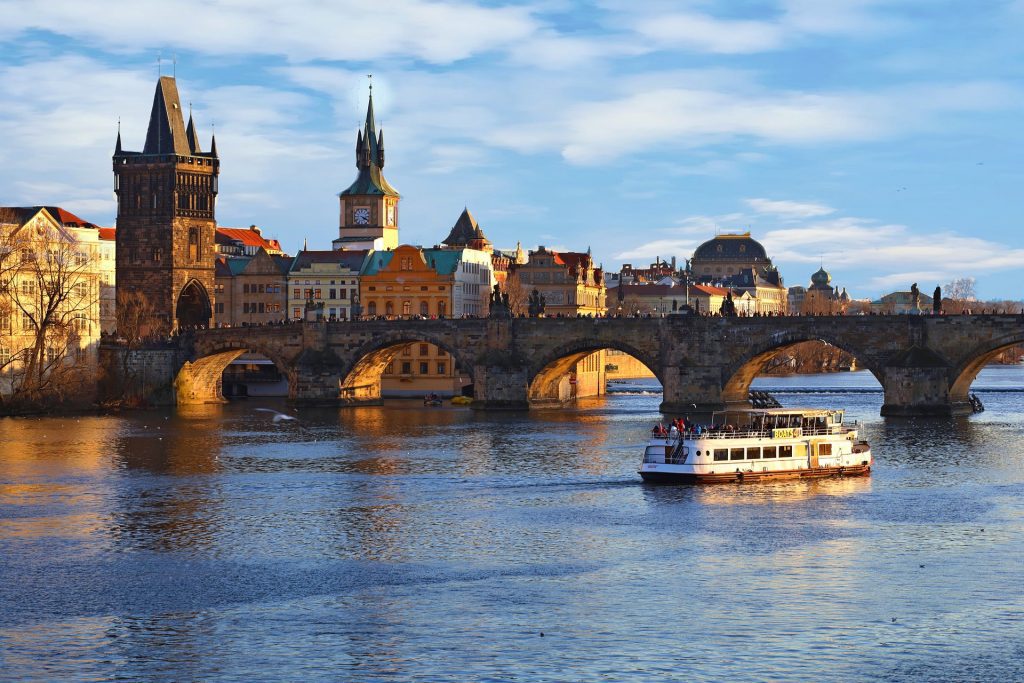
During the 14th century, Prague became a political and economical power and King Charles’s Bridge boosted its popularity. This led to it becoming heavily traveled and the need for expansion arose; this caused the bridge to be reconstructed in 1602 by adding Count Jaroslav II Thurn’s gothic statues. The year after the bridge’s reconstruction, it was destroyed by a fire. In 1639, the stone balustrade and statuary were added to complete their appearance today.
Charles Bridge offers beautiful views of the surrounding area from all angles whether you are on foot or crossing it via a boat ride along the river. The view includes Gothic buildings that line the riverbanks, and statues on Charles Bridge, and on both sides of the bridge. In addition to the beauty it offers from a physical perspective, it also has some historical significance. You can see how it has been renovated over time while you admire its history.
5. Old Jewish Ghetto
The Old Jewish Ghetto in Prague, Czech Republic is a historic quarter of the city formerly walled off and used primarily by Jewish residents. The quarter contains two famous synagogues: the Old-New Synagogue built in 1270 and the High Synagogue built in 1866 after a fire that destroyed a large portion of a prayer house that had stood on the site since 1420. The Old Jewish Cemetery is also located in this area of Prague, founded in the late 15th century and used until 1787.
6. Prague Castle, also called the ‘Crown of Bohemia’
Prague Castle, sometimes called the ‘Crown of Bohemia’, is a prominent landmark in Prague and dates back to the 9th Century. It houses many treasures and artifacts and has many museums and churches within its perimeter.
Historically, this castle has been home to rulers such as Emperors, Kings Catholics, and even Hussites. It is also home to St. Vitus Cathedral, which contains artifacts such as the 10th century Bohemian Coronation Gospels and the saint’s relics. It is Gothic in style with some Baroque influences.
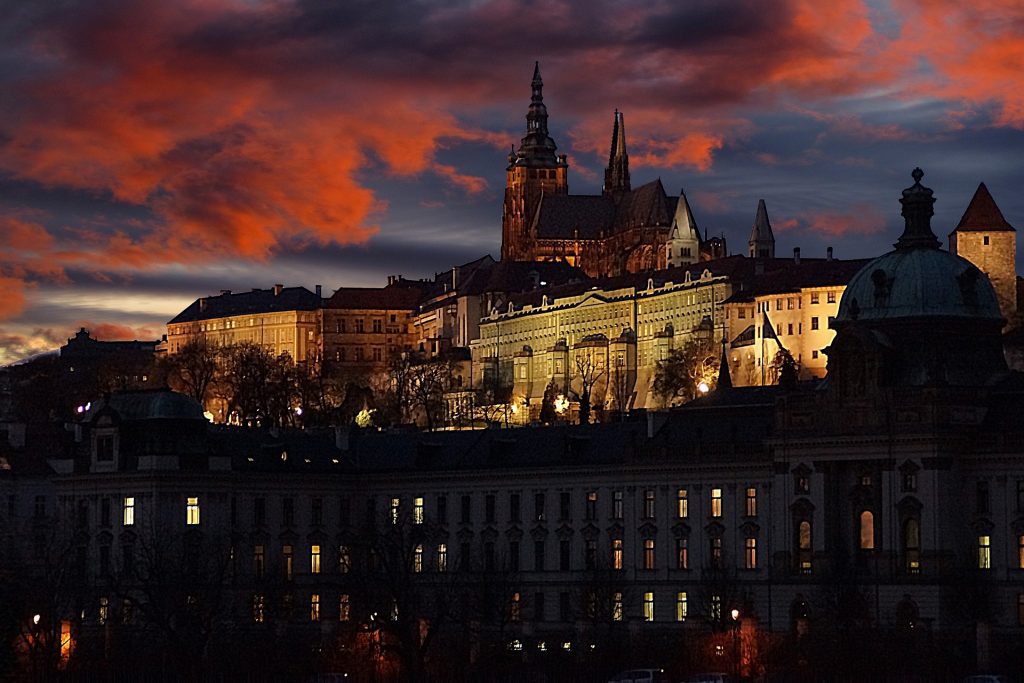
The Old Royal Palace of Prague Castle houses the Czech Crown Jewels that were originally acquired by Holy Roman Emperor Charles IV in 1347. This castle is also the official residence of the President of The Czech Republic.
The main sights at Prague Castle are definitely St Vitus Cathedral, Golden Lane with Daliborka Tower, Old Royal Palace (St Vitus Cathedral), Stag Moat and Powder Tower, Convent of St George, Prague Castle Picture Gallery, Lobkowicz Palace, Spanish Riding School, and the Summer Riding School.
The St Vitus Cathedral is also known as ‘the saint’s stone temple’ or ‘the basilica of St. Vitus’. It has five naves with ambulatory galleries over them which are supported by flying buttresses.
The cathedral houses the Czech Crown Jewels which are displayed in a separate room. These treasures include royal insignia, coronation jewels of Bohemian kings, and regalia of many other rulers.
Also to see are the relics of St Vitus himself contained within two vials that are kept at the main altar.
Bestseller Drones
There is also a copy of The Good Shepherd, painted in 1420 by an unknown artist and it is considered to be among the world’s most valuable paintings.
There are many churches and galleries within Prague Castle with varying opening times.
The Old Royal Palace is not currently open to visitors, but guided tours of the Lobkowicz Palace are available through the Prague Castle Administration.
The St Vitus Cathedral houses the St Wenceslas Treasury which includes some of the oldest relics in Bohemia. These include fragments of the True Cross, vials with some blood of Christ, and pieces of Mary’s veil. Also included are reliquaries made for Charles IV, Albrecht II, and Rudolf II and the golden reliquary of St Wenceslas.
The Prague Castle Picture Gallery has a collection of paintings, sculptures, and furniture that is displayed throughout the castle’s many rooms.
Also at Prague Castle is the Lobkowicz Palace which houses a collection of musical manuscripts and portraits.
The Spanish Riding School is a separate building housed in a wing of the castle which was once used as a military hospital by the knights of the Order of St. John. This is where the famous white Lipizzaner horses are trained and kept as well as some other types of horses.
The Summer Riding School is also in the same area and it contains a collection of more than 50 antique horse-drawn vehicles.
The Stag Moat is a structure that was built by King Ferdinand I in the 16th century to provide water for the castle.
7. St Vitus Cathedral
St Vitus Cathedral is the cathedral of the Archdiocese of Prague. It is one of Prague’s most important historical monuments and definitely worth a visit.
St Vitus Cathedral was built in the 13th century and served as the coronation church of Bohemian kings for about 800 years. With its 78 meters in height against the background of the Prague skyline, it is one of the most impressive buildings in Europe.
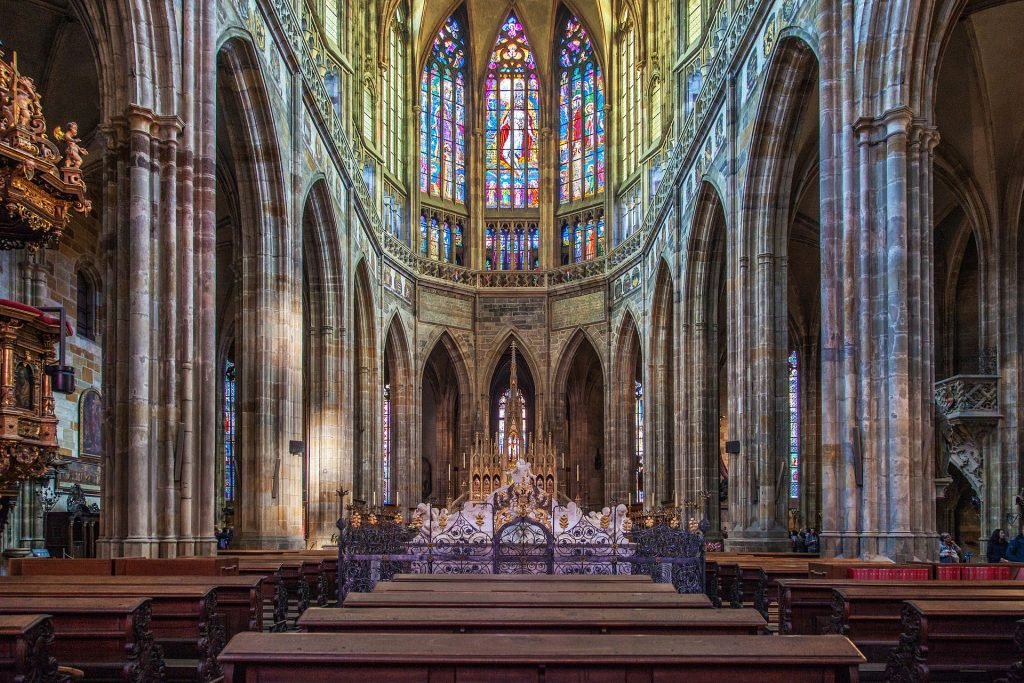
The cathedral’s construction was begun around 1220 by Prince Vratislav II who also founded St Wolfgang monastery nearby – immediately before his death in battle against Ottokar I of Bohemia. The choir and crypt were founded by his son, Prince Boleslav II. Construction was halted during the Hussite wars until it resumed in 1430 when the foundations of the nave and towers were created. It wasn’t until the early 16th century that construction continued, led by architect Benedikt Rejt who changed most of Vratislav’s original plans to adapt the cathedral to Renaissance style. The church was finally completed around 1560, more than 50 years later.
St Vitus Cathedral’s most striking feature is its buttressed central tower, which occupies one-third of the length and width of the entire structure – a rather unusual proportion for this type of architecture. The technique used in building it is called “triforium”, which enabled the creation of expansive interior space.
The cathedral has been involved in several tragic events. The first took place on Palm Sunday, 29 March 1361, when a fire broke out during church services, and only half of the church was destroyed. As a result, many important art pieces were lost. A century later, another fire (7 August 1419) destroyed the rest of the cathedral and it wasn’t until the last decades of the 15th century that it was reconstructed.
St Vitus Cathedral’s most tragic moment, however, undoubtedly took place on 21 June 1618 when a Bohemian Estates’ army stormed Prague Castle and massacred the garrison that was protecting it. Some 5,000 of them took refuge in St Vitus Cathedral but were dragged out and killed on its front steps.
The cathedral is now enlisted as a UNESCO World Heritage Site as an outstanding example of Gothic architecture in Bohemia and as one of the most remarkable examples of sacred architecture anywhere. It is visited by numerous people each year and is definitely worth visiting while you’re in Prague.
8. Golden Lane
Golden Lane is the name coined for the tiny, picturesque street and its surrounding buildings in Prague. Although it can be considered a part of Prague Castle, Golden Lane has an independent status as a National Cultural Monument of the Czech Republic, with its own cadastral number and administration under the Museum of Czech Literature.
The street is short and narrow but is lined with dwellings that have remained unchanged since the sixteenth century. The buildings, numbering twenty-nine in all, are mostly small two-storied cottages of approximately ten meters long and four meters wide with arched roofs.
Prior to being protected as cultural monuments, some of the homes had deteriorated into slums where poor citizens of Prague lived. Most of the houses have been refurbished from their used as dwellings to being used as gift shops and small cafes, but a few are still inhabited by the descendants of those who originally built them.
For most visitors, there is not much to see on this street, nor is it possible to visit the interior rooms of the cottages. However, you can still enjoy the street itself and look at its renaissance-era gables (gingerbread roofs), loggias with painted scenes, statuettes of dragons on beams, tourelles with oriels, etc. The most beautiful are No. 18, No. 17/23, and No. 21/4.
Golden Lane is located just outside the south wall of Prague Castle. The street begins at the corner of Maiselova and Maltézské náměstí streets and ends on Maltézské náměstí itself, after a right turn. It is accessible from the Malostranská metro station.
The street comes to an end in a large open area popular for wedding photography. It is here that the Maltese (Czech: “Maltézský”) Barracks, which in the past provided accommodation for soldiers of this religious order and now house the National Gallery collection of 19th-century Czech art, are located.
Artists who lived on this street include Petr Brandl and his student Josef Mánes. The artist Karel Škréta lived in Golden Lane during 1622 – 1623.
During the Thirty Years’ War, Golden Lane was occupied by Swedish soldiers of King Gustavus Adolphus who had taken Prague. In 1632, during the events of the war, Rudolf II and his brother and successor Matthias died here. Their bodies lie buried in St Vitus Cathedral.
In 1848, during the revolutionary days that preceded the Battle of Prague, Golden Lane was a temporary prison for Austrian soldiers captured by Czech forces.
In 1938, Golden Lane was a location for the deposed Czechoslovak president Edvard Beneš to flee to London during the Nazi Occupation of Czechoslovakia in World War II.
9. KGB Museum, Prague
The KGB Museum in Prague is a small part of the capital’s history that many people may not know about. The museum is located only a short walk from Prague’s Old Town Square and offers a unique look into the history of surveillance in what was once Czechoslovakia.
The KGB museum is located on Poupětova 1, Praha 7. It is open from 9 a.m. to 5 p.m., Monday through Friday, and 10 a.m. to 4 p.m. on Saturdays and Sundays from April through October; closed Mondays, Tuesdays, December 24th-26th; open Wednesday through Sunday from November through March.
The KGB Museum is a small museum that offers visitors a glimpse into the surveillance techniques used by the Russian Secret Police, or KGB, during Soviet rule in Czechoslovakia from 1948 to 1989.
10. Stare Mesto (Old Town)
Stare Mesto (Old Town) is the historic center of Prague. It is one of the best-preserved historical towns in Europe and comprises over 10% of the entire city. The cobbled streets, Gothic churches, palaces, and burgher houses are simply breathtaking.
It is a UNESCO World Heritage site and one of the most popular tourist attractions in Europe.
The Church of Our Lady Victorious above the River Moldau, Cathedral of St Vitus, Prague Castle, and many other places can all be found here. Another famous attraction is the statue of psychoanalyst Sigmund Freud which resides on the banks of the Moldau river.
Freud was born in what is now the Czech Republic, then part of the Austro-Hungarian Empire. He later emigrated to Austria and then to England, where he died in 1939 just months before the outbreak of World War II. The statue dates from 1967 and stands near Charles Bridge at Malostranske Namesti.
The statue was designed by the famous Czech sculptor Jaroslav Rona (he also created the Jan Hus Memorial, another UNESCO site). The statue depicts Freud crouched down sitting on a bench, buried in thought. It is not an obvious tribute to his work but rather shows him as a humble figure contemplating the beauty of the city.
Best Things to do in Prague 11-20
11. The Lennon Wall, Prague
The Lennon Wall is a popular tourist attraction in Prague, Czech Republic. The wall was created by John Lennon-inspired graffiti artists who saw it as the only place where they could express their love for the former Beatle.
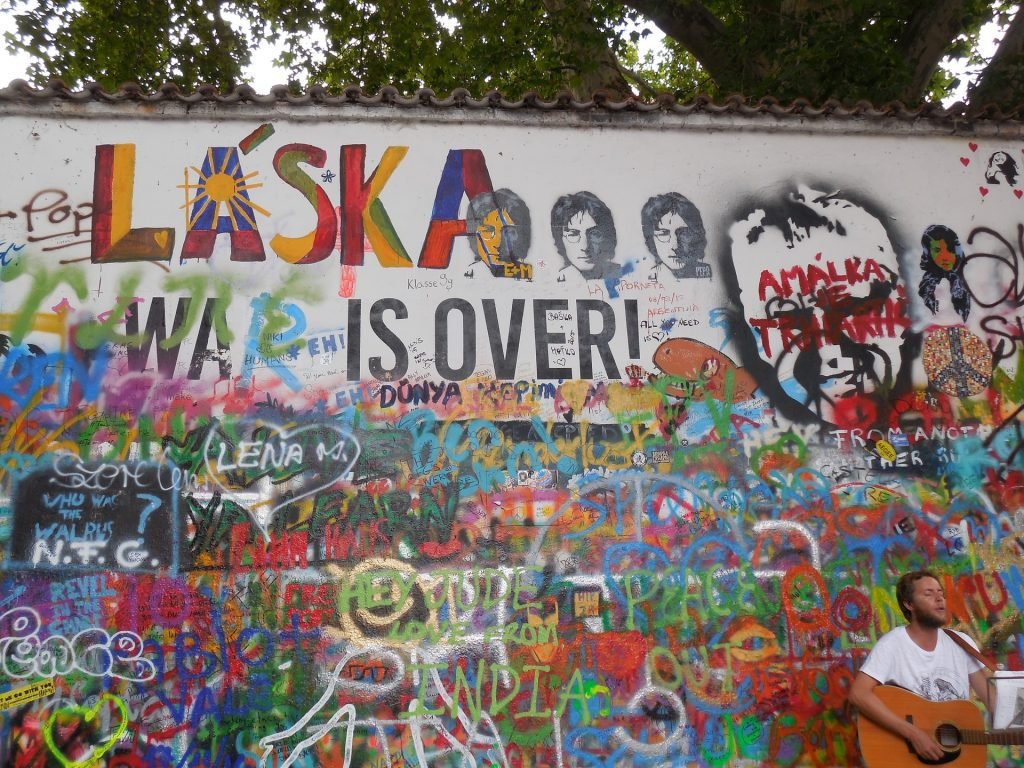
The wall was created in 1981, during a period of soviet communist rule over what used to be Czechoslovakia. On the anniversary of Lennon’s death (December 8th), fans and admirers go to the wall and write messages and leave flowers as a tribute to the singer. People also use it as a canvas for graffiti art.
The wall is located in Prague’s city center, on the outer wall of Lucerna Palace near Charles Bridge. It can be reached by taking Metro Line C to IGR Plaza Station or tram lines 6, 7, or 18 to Vodičkova Stop.
12. Farmer’s market
Farmer’s markets are popping up all over the place, it seems. Not only are they fun to visit but they are usually very fresh! Farmer’s market in Prague is no exception. While you can certainly buy produce here, don’t forget that you’ll also find cheeses, meats, eggs, and much more. This market is held at Náplavka (a park along the river) and is open on Saturdays year-round.
With views like these, you’ll be snapped up with how beautiful it is out here!
To get there, take the Metro or tram to Náplavka station. Once outside, walk towards the river and take a left at Vyšehrad street. The market will be on your right side after about 5 minutes of walking.
13. Vltava River
The best way to see Prague is from the Vltava River. A boat cruise will give you a new perspective of this city and will allow you to get an overall view of the beauty that lies upon its shores.
There are many tour companies in Prague, along with many boat excursions that are not pre-planned. The main cruise company for tourists is Mahart, which provides a large variety of tours on boats that are all very grand. They offer day-long cruises, several hour-long cruises, and romantic evening cruises.
The most popular tour by the company is the afternoon tour of the city, which is one and a half-hour long cruise. The best place to embark on this boat trip is from the docks at Dlouha Stromovka Park near the National Theatre. Once you are on board, your guide will help take you through many of Prague’s important sights as she describes their history.
Some sites include Charles Bridge, Old Town Square, and Prague Castle.
Another tour is an evening cruise which also lasts about one and a half hours, taking you on a twilight view of the city. The most stunning part of this ride is how it revolves under dozens of bridges that are lit with hundreds of lamps that create a great view for passengers. The best place to embark on this boat trip is in the inlet at Dlouha Stromovka Park near the National Theatre.
Another trip offered by Mahart goes up the Vltava River, which takes about three hours. This day-long cruise allows you to see parts of Prague that are far away from any hotels or restaurants, giving you a true feel for the country. The boat makes its way through the nearby countryside where castles and churches can be seen in the distance.
Those who are interested in going on a cruise should come to either Dlouha Stromovka Park at 10:00 or 14:00 to get a ticket, which costs about 145 koruna. You can also purchase tickets online for your choice of time and date.
14. Mala Strana
Also known as the small town quarter, Mala Strana is home to some of Prague’s best historic sites and traditional cobblestone paths. This district is also renowned for its fine cuisine, rich history, beautiful vistas, hidden gardens, and picturesque alleyways. The backstreets of this neighborhood are perfect for quiet exploration with their calm atmosphere and decaying architecture.
Saint Nicholas Church is located on the edge of a park in Mala Strana. It was built in 1134, this Gothic church has survived wars, fires, and pillaging invaders to be one of the best-preserved churches in Prague. It stands proudly upon the bank of the Vltava River with an excellent view of Prague Castle in the background.
For an excellent view of Mala Strana’s picturesque alleyways, consider ascending to the top of Petrin Hill. A scenic climb for visitors of all ages leads up to the Petrin Lookout Tower which was built in 1891. The tower is situated on a steep hill that has wonderful views across Prague with the sights of Prague Castle and Charles Bridge in sight.
Pig Iron Theatre (named after the famous Lonesome West play by Martin McDonagh) is a small theater that hosts an extremely versatile group of artists who perform on both stage and screen. They specialize in innovative physical performances which are thought-provoking, entertaining, and often hilarious. The theater is located in a house from the 19th century and plays screen adaptations of McDonagh’s plays in addition to their original productions.
15. Nightlife in Prague
The nightlife in Prague is full of energy, excitement, and fun. It’s no wonder that many international students return to the city as a popular destination for stag parties. The fact that alcohol is relatively inexpensive only adds to the appeal. Prices vary from place to place but generally beer costs around 25 CZK ($1), while spirits are around 30-40 CZK ($1.5–2).
Czechs drink a lot of beer and it is relatively inexpensive compared to other European countries. If you go to a typical bar, the waiter will ask what type of beer you desire and serve it in about two minutes. The price for a half-liter glass ranges from 20 to 35 CZK. The waiters normally collect the empty glasses and bring new ones, unless you explicitly ask them not to do so.
By law, pubs are obliged to give you tap water for free with your beer; mixing tap water and alcohol is frowned upon (although it happens in some places), so many travelers drink only beer. Beer is actually quite nice and a good deal when you compare it to other countries, such as the UK or Germany, where buying even a half liter in a pub might cost around £3-4 ($6–9).
If beer is not your cup of tea, try one of many pubs serving various types of Czech spirits (either straight or mixed with a soft drink). The main types of Czech spirits are Becherovka (herbal bitter, similar in taste to Jagermeister but without bitterness) and slivovitz (plum brandy). Try also svařák, borovička and medovina.
As far as clubs are concerned, they usually don’t open before 11 pm. Most locals go out around midnight (when the streets are more crowded) and go home around 2 am (when streets are emptier). The popularity of bars or nightclubs varies. Some places become very crowded, but it depends on the location; for example, Karlovy Lázně is a small place, but it attracts many tourists and locals alike.
Smoking restrictions have been imposed on the whole country. However, some places—mostly pubs and restaurants—are trying to circumvent the ban by establishing separate smoking rooms (which do not violate the regulations). The non-smoking signs should be clearly visible in such establishments.
Also, smoking is prohibited on public transport, and in some other outdoor areas like schools and castle grounds. It is allowed to smoke on the street – it may be subject to a fine. On national holidays there are usually more relaxed rules: for example, many places will serve beer for free for all the people having parties outdoors.
Prague nightlife is famous across Europe. Clubs are open until the early hours, catering to all tastes. Live music and DJs can be found throughout Prague, with popular clubs playing a mix of Western house, trance, and techno to Czech rock and pop.
The best place for a beer is U Fleků. One of Prague’s oldest and best-known pubs, it has a brewery inside and a summer garden serving hops beer, and traditional food. It is very popular among tourists and locals, especially after the theater.
16. Petrin Hill
Petrin Hill, Prague, Czech Republic. Petrin Hill is the smallest of the four man-made hills surrounding Prague’s old city. The hill was built in 1838. Petrin hill was built from soil dug up when the city fortifications were being demolished.
The hill has a funicular railway. There are also two restaurants there. The hill affords nice views of the entire city, including Prague Castle.
Situated in the center of the city, Petrin Hill is a man-made mountain made from soil dug up when the city fortifications were being demolished. Not for much longer however as it was decided that this small hill would be to build an observation tower from which to view Prague. The idea was to build a similar structure as they had in Paris, but this was never built. Construction began in 1874 but was not completed until 20 years later. The overall cost of the project was estimated at 4 million guldens.
There are two restaurants at the top along with a funicular railway to get there if you don’t want to walk up the hill. The view from the top is great, especially at night.
Completed in 1891 after almost 20 years of construction. The tower was built to allow for viewing the city and replaced a similar structure in Paris which had been destroyed by Napoleon Bonaparte’s troops during the French occupation of Prague.
The hill affords nice views both day and night. The original project was to build a similar structure as they had in Paris, but this was never built. Construction began in 1874 but was not completed until 20 years later. The overall cost of the project was estimated at 4 million guldens.
17. Letna Park
Letna Park is a great place to get out of the city, enjoy nature, and relax. The park has two main parts: The Letna Plain, which was once used for military drills, and Mount Petrin.
The Letna Plain offers beautiful views over the entire city. There are several restaurants on top of the hill where people will sit and eat while enjoying the view. There is also a bar on top of Mount Petrin with a beautiful view.
Prague Castle, Lesser Town, and Charles Bridge are all visible from the park. One can also see the Vltava River flowing through Prague from this vantage point.
There is a festival held in Letna Park every year from June 28 to July 6. The festival is a celebration of the end of World War II and features traditional food, drinks, costumed dancers, and singers.
Another major festival that takes place in the park is the Strawberry Festival which is held in late August/early September. This festival also features local cuisine and live music.
The park is also home to many peacocks and swans who live freely in the park. The animals are well-known for wandering onto surrounding streets and even into local restaurants, much to the amusement of onlookers.
Letna Park provides a unique experience for people visiting Prague and is not to be missed by outdoor enthusiasts.
18. Mind Maze
Mind Maze is an escape room attraction that operates in multiple locations across Prague, Czech Republic. On their website, they state “The rooms are divided into several categories according to the difficulty level of the game.”
Escaping Mind Maze requires teams to work together and use different skills to solve puzzles. The goal of each room is for each team member to find their way out.
In order to fully experience this attraction, it is advised that visitors have a general knowledge of the Czech language.
19. Jelení Príkop (Stag Moat)
The Jelení Príkop (Stag Moat) is a former fortification in Prague, Czech Republic. It was built between 1475 and 1483 by the King Ladislav II Jagellonský of Poland and his son Jan Olbracht to repel attacks from Hungary and Austria. It is located on the right bank of the Vltava south of Hradčany.
The fortification gets its name from the Czech name for deer, “jelení”. It got this name because looking out on the moat on one side is a statue of a deer which was carved by Matthias Braun in 1563.
After the Second World War, the moat was filled in and a metro station was built there. In 1994–96, Jelení príkop was restored to its original plans.
In 2009 an exhibition of medieval armory called “City of Steel” was held at this location. The moats were also opened again to the public.
This is a great place to visit and explore, especially if you love history and castles!
20. Beer Tours in Prague
“Beer tours” in Prague are becoming increasingly popular, and you can find a good one at pretty much every hostel in the city. Many of them include a free drink and some food, but it’s often rather mediocre. Luckily for beer lovers, there is another option: The Original Prague Beer Tour [OPPT].
The OPPT is a small company that operates as a private tour, meaning you’ll be taken to some of the best places in the city. During the tour, you’ll visit three different Prague pubs and enjoy an authentic Czech beer specialty at each one. The OPPT “Beer Specialist” will give you plenty of interesting information about beer-drinking traditions, beers themselves, and the Czech pub culture.
The tour lasts for about 4 hours, which also gives you plenty of time to explore the old town on your own afterward. The price of the tour varies depending on group size but is between 800 CZK (about 30 euros) per person. There are no fixed dates so you can choose whatever fits your schedule.
A big bonus is that you can book the tour in advance over the Internet, which makes it easy to plan ahead when you’re on a trip. All you do is inform them of your arrival time in Prague and they’ll arrange everything else for you. You can also check out their Facebook page to find out about upcoming events.
Best Things to do in Prague 21 and beyond
21. Wenceslas Square (Czech: Václavské náměstí)
Wenceslas Square (Czech: Václavské náměstí, colloquially Wence) is one of the main squares and the center of the business and cultural communities in the New Town of Prague, Czech Republic. Many historical events occurred here; up to 28 laws were signed or executed within this square. It is a traditional setting for demonstrations and parades and is often referred to as the “heart of the Czech Republic”.
Wenceslas Square (Václavské náměstí) was designed by architect Jan Kotěra and built in 1885–1891. The square was named after Saint Wenceslas I, Duke of Bohemia. Before 1841 it was known as “Náměstí Republiky” (Square of the Republic) and later Kirchplatz (Square of the Church). The second part of the name of Wenceslas Square refers to King Wenceslaus I of Bohemia who was killed in the year 935 by his brother Boleslaus.
The square was originally rectangular and its sides were named after the new roads: Paris Street (today Havlíčkovy sady), Roosevelt Street (today Na Příkopě), and Madrid Street (today Václavské náměstí). The Square was opened in 1891 as part of the New Town and its construction was finished in 1897. In 1926 the large equestrian statue of Wenceslas I by sculptor Josef Václav Myslbek (1848–1922) was erected in the middle of the square, replacing an older statue of the late Emperor Franz Joseph I by Ferdinand Brokoff.
Wenceslas Square was the site of two executions by Nazi Germany firing squads.
- The first one was on October 27, 1941, when Milada Horáková and nine others were shot. The place of the execution was chosen in order to make it visible from the offices of the Nazi governor of Bohemia and Moravia, Karl Hermann Frank.
- The second one was on June 18, 1942, when nine people were hanged in public on Wenceslas Square by an execution squad of the SS.
The Czechoslovak national liberation uprising was started by activities of the student groups on October 29, 1944. After the occupation, the Germans tried to suppress this symbol of liberation. They sent Vlassov’s Russian soldiers to search for people who would collaborate with the Nazis to shoot at the insurgents. On November 17, 1944, thousands of citizens met to commemorate the 18th anniversary of Czechoslovak independence. Germans forbade the demonstration, but the people refused to leave. Two SS guards were killed and some German windows in nearby buildings were smashed before the German firing squads suppressed the demonstration. More than 1700 people were arrested and taken to the Mauthausen concentration camp (Slovakia), where 199 of them were killed.
After the war, a postage stamp was issued to commemorate these events. It shows an insurgent aiming his submachine gun at the viewer. The square was renovated in 1995 to mark the 500th anniversary of the Wenceslas Square Defenestration. A small museum, centered on a replica of the Jan Hus Memorial, was also installed. The square is now a popular site for demonstrations and the place where the Czech political scene can be seen in action.
Out of the list of the Best Things To Do in Prague, you can pick and choose which ones you want to cover depending on your preferences and how much time you have available on hand. We’d recommend doing all of them!
There’s so much to experience and see in Prague. For your next trip, make sure you check out all the things mentioned in this article!
Tip: The Prague Card Can Save You Time and Money
The Prague Card or the Prague CoolPass is a prepaid card that allows the user to access unlimited public transportation and free entrance to many of Prague’s museums, castles, and galleries.
The card also offers discounts at restaurants, shops, bars, clubs, and car rentals. The card can be purchased for periods of 48 hours (76 Euro), 72 hours (87 Euro), and 96 hours (94 Euro). The card can be purchased online, as well as at many hotels, hostels, and other accommodation facilities in Prague, at the airport upon exiting the baggage reclaim hall, and at other locations around the city.
Read also:
- Paris: 41 Best Things To Do in Paris – The City of Lights
- Nice: 20 Best Things to do in Nice, France
- Normandy: Ignore These 22 Best Things to do in Normandy, France at Your Own Peril
- Hamburg: Ultimate Guide to 30 Best Things to do in Hamburg, Germany
- Milan: 31 Best Things to do in Milan, Italy
- Rome: 25 Best Things to Do in Rome – Beautiful & Historic City of Italy
- Naples: 25 Best Things To Do In Naples, Italy
- Florence: Plan a Trip For 2 Days in Florence, Italy
- Barcelona: 27 Best Things To Do in Barcelona – Gaudi’s Town
- Seville: 18 Best Things to do in Seville, Spain
- Lucerne: 15 Best Things to do in Lucerne, Switzerland
- London: 21 Best Things to do in London That Will Knock Your Socks Off
- Brussels: 39 Best Things to do in Brussels – Beautiful Belgian Capital
- Luxembourg: 26 Best Things to do in Luxembourg – Europe’s Beautiful Small Country
- Monaco: 24 Best Things To Do in Monaco – The Stylish City-State in French Riviera
- Amsterdam: 24 Best Things to do in Amsterdam – The Beautiful Dutch City
- Bruges: 22 Best Things to Do in Bruges – The Stunning Belgian Fairytale Town
- Croatia: 28 Best Things To Do in Croatia For Ultimate Experience
- Faroe Islands: 17 Best Things To Do In Faroe Islands Archipelago
- Prague: 21 Best Things to do in Prague -The Pretty Czech City.
- 29 Best International Spring Break Destinations
- 48 Best Spring Break Destinations in USA
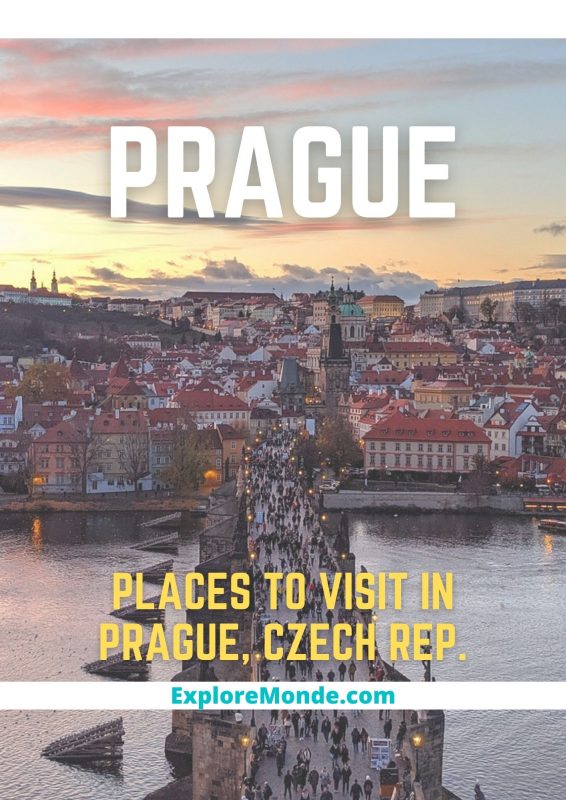
Note: The hours of operation, ticket prices, and admission criteria of museums, parks, etc. may change from time to time. For the most updated information, we recommend checking the official website of the attraction directly prior to your planned visit.
Categories: Asia | Africa | Europe | USA | Australia & New Zealand | France | Germany | India | Italy | Spain | Sports | Switzerland | Travel Tips | UK | Products | Download AI Trip Planner App
Page Contents










